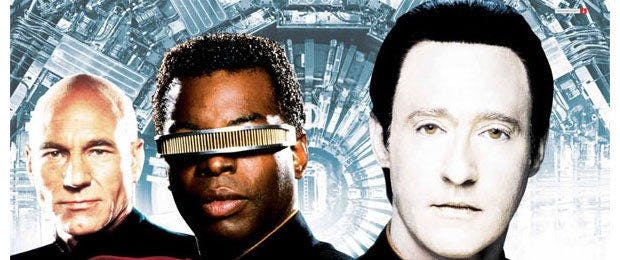Published May 6, 2011
Star Trek Magazine Issue #34 Preview
Star Trek Magazine Issue #34 Preview

The latest issue of Star Trek Magazine – #34, due out May 10th – is filled to the brim with thought-provoking, entertaining pieces, including a very special edition of their regular Treknology column, in which Dr. Chris Dows assesses just how close we’ve already come to realizing some of the technology seen in Star Trek… 350 years before the Enterprise-D set sail, and a feature in which Marco Palmieri investigates how the designers at Anovos approach their new Star Trek costume replicas. StarTrek.com is pleased to offer the following exclusive previews straight from the editor’s desk.
Join Dr. Chris Dows as he beams into the Ready Room for his Treknology column:
Having got a nod of permission from Captain Picard, let's stroll into his ready room and start our tour. We'll resist the temptation of ordering “Tea. Earl Grey. Hot,” because while there are machines in production that can replicate engineering parts automatically out of high-density plastics and alloys, restructuring atoms for a hot drink works along the same lines as a transporter - so we'll just put the kettle on instead. Some things look immediately familiar; there's a desktop monitor roughly the same size and shape as the millions of TFT and LED screens available around the world, hooked into an optical network allowing fast and secure data transfer between servers and host machines. It has more than a passing resemblance to the Internet both conceptually and mechanically, so it looks as though we're on a Trek-becomes-reality roll.
Before we leave Livingston to get on with his swimming, let's briefly consider what keeps the captain's lionfish, and indeed everything else, from floating aimlessly around the room. It is possible to simulate the effects of gravity through the rotation of a spacecraft in flight thanks to Newton's Third Law and the effect of centripetal force, but the radius of the ship's hull would have to be very wide combined with a relatively slow rate of spin to get around the detrimental effects on the bodies of the crew as they moved towards or away from the center of rotation. The idea of using magnetic fields similar to the artificial gravity plating underfoot has been investigated by the space exploration community; unfortunately, current technology would generate fields so intense they'd eventually kill anyone exposed to them.
However, like so much “impossible” Treknology, it only takes the development of a key material to increase the chance of its existence. As an example, let's take a look through Captain Picard's viewing window - glass as strong as steel was crucial to saving the whales in Star Trek IV and Scotty's deft molecular restructuring formed one of the biggest laughs in the film, but palladium-based metallic glass is now a reality and currently being tested by Berkeley Labs and Caltech in the U.S. Pretty good strike rate so far.
And now go behind the scenes at Anovos with Marco Palmieri…
"The Captain's Wrap was inspired by our special access to veteran Star Trek modeler and prop collector Greg Jein's screen-used wrap," notes Anovos CEO Joe Salcedo. "We were allowed to not only picture but also create a pattern from it, using a professional team of pattern makers. One of our key collaborators, Vic Mignogna, also discovered an invaluable source for the double-knit green wool with little alteration to the color or texture. When this was matched to the reference photos and Pantone cards, the weight and color was a great match. This will be the definitive replica to this unique alternative captain's outfit.
"Regarding the Cadet Uniforms, we were very lucky to discover the original team that outfitted over 200 background cadets for the actual production,” Salcedo continues. “The material was correctly sourced and the craftsmanship is impeccable. This outfit features a hidden zipper and complete construction with finished bottoms, ready to wear."
Anovos's dedication to accuracy has at times led to surprising discoveries, according to the company's other co-founder, Dana Gasser: "A couple of things which amazed me about the Captain's Wrap was it was made of a lightweight wool and had no lining," he reveals. "This had to be itchy to wear. Since there was no lining, the excess material was hand basted, giving it a unique look from the outside. On the inside hip area was a small hook with elastic. This appears to have been used to clip to the pants and keep the wrap from riding up.
"The fabric on the Cadet Uniform turned out to be thicker than it appears on screen and is the weight of what you would find on upholstery,” Gasser adds. “It must have been very warm to wear with the addition of the knitted sweater underneath.”
You can read these articles in full in Star Trek Magazine #34, on sale May 10th, available from all good retailers and specialist comic stores.
Subscriptions are now available worldwide. To subscribe, click here.
This magazine is also available digitally to read in full on PC, Mac or iPad. For a digital subscription, click here.
Connect with Star Trek Magazine on Facebook.

